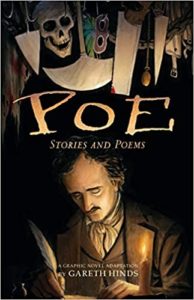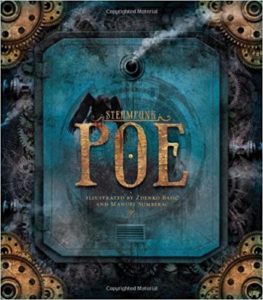Illustrated Stories and Poems of Edgar Allan Poe

 Poe: Stories and Poems, a Graphic Novel Adaptation, by Gareth Hinds
Poe: Stories and Poems, a Graphic Novel Adaptation, by Gareth Hinds
Steampunk Poe, illustrated by Zdenko Basic and Manuel Sumberac
Halloween’s almost here, and I can’t wait! October’s put me in the mood for spooky reads despite the fact that the scariest thing I can handle are the sharks in Finding Nemo.
Edgar Allan Poe is the answer. He’s a master of suspense, originator of chilling mysteries, and definitely meets any seasonal wish for an eerie atmosphere . Although many of his works are considered horror classics, I am able to read “The Raven” and still sleep at night.
Searching for Poe’s works, I ran across a surprising variety of different versions–films, retellings, audiobooks, graphic novels–including a concept album by the Alan Parsons Project. (Who knew?) There’s certainly more than one way to interact with a text. Sometimes an unexpected approach to a story or poem–especially a classic–can open the door for a skeptical reader.
To that end, here are two visual adaptations to enjoy. Think of it as Poe prepared two ways: lightly illustrated and fully drawn.
In Steampunk Poe, Croatian illustrators Zdenko Basic and Manuel Sumberac sprinkle the book with full-color art emphasizing the shadowy world of Edgar Allan Poe’s works. Dark browns, greys, and greens pair with lots of black and highlights of oil-rubbed bronze to reinforce the steampunk aesthetic. Steampunk–the sci fi subgenre depicting advanced technology as if it were based in 19th century steam-powered machinery–lends itself to Poe’s creepier stories. Basic and Sumberac populate their illustrations with plenty of gears, cogs, wheels, and pulleys, particularly as frames. And, they punch up red as an accent to great effect. In the final image for “The Masque of the Red Death” (one of my favorites), a giant Death hooded in a primitive gas mask, wearing a blood-soaked white gown and ermine-trimmed crimson robe towers in front of a full moon playing a colossal puppet master to the distant, fog-shrouded city below.
Steampunk Poe serves up Poe’s original stories and poems in an easier-to-read format without changing any of his text. The usual suspects appear along with a few unfamiliar titles (“The Spectacles”, “The System of Doctor Tarr and Professor Fether”, “The Conqueror Worm”). Pages have plenty of white space plus double-spaced text which can increase accessibility for many readers who might be turned off by tissue-thin paper filled with microscopic fonts. Trust me, the adage “you eat with your eyes” applies just as much to the consumption of books as it does to food.
Artist Gareth Hinds provides a visual feast for readers in Poe: Stories and Poems, a Graphic Novel Adaptation. His mixed media illustrations evoke the macabre horror of seven of Poe’s best known works without stooping to gratuitous gore. Each entry has its own style down to the texture and color scheme. The final panel of “Annabel Lee” reads like a Roz Chast cartoon with extra-vibrant hues. A sky the color of a KC Royals jersey offsets the luminous, white sand castle shrine punctuated by seashell mermaids and grottos, all of it the life’s work of the narrator who has built his final resting place in front of the sepulchre doors. “The Cask of Amontillado” depicts the ossuaries of the Paris catacombs, skulls and femurs stacked everywhere, with long, deliberate brushstrokes covering a gritty surface reminiscent of a trowel scraping mortar. Texture is key in “The Tell-Tale Heart” where grainy stippling depicts the descent into murderous madness, growing rougher as the thumping heart grows louder. The book ends with “The Raven”, Edgar Allan Poe himself as the narrator accompanied by pencil drawings blended to a fuzzy, dreamlike patina. Just when it seems this is a straightforward rendering, a closeup of the bird reveals skulls and claws and bony hands hidden in its feathers. Hinds throws in more visual treats as the poem progresses, culminating in a pair of exquisite two-page spreads you absolutely have to see for yourself.
Hinds is skilled at engaging students with Western classics via graphic novels. Here, he adds valuable resources that help make Poe more easily understood. A three-page “Author’s Note” includes a brief biography of Poe plus background information on each selection. “The Poe Checklist” outlines a series of icons used at the start of each title to identify recurring motifs in the text.
If you’re new to the mysteries of Edgar Allan Poe’s creepy universe, these titles are a great place to start. They’re equally great access points if you read Poe because you had to the first time around. Whether his stories and poems are in words or pictures (or both), Poe’s tales can make your flesh crawl and your spine tingle. Either book would be great for adults and for teens in upper middle school and older. Although both titles use Poe’s original texts, each version offers possibilities for students wishing for a less painful way to read an assigned classic. You can discover these and other spooky tales at the Library or through our electronic resources. Happy reading!

